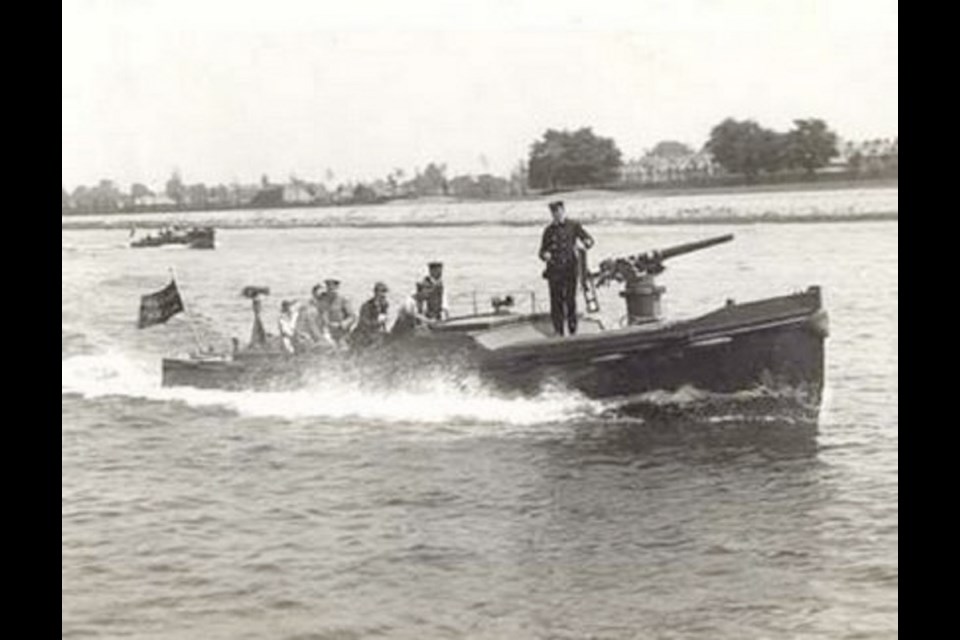Dec. 26, 2015, was the 100th anniversary of one of the strangest naval battles of the First World War, when an eccentric British officer who had married a woman from Victoria took on the German navy with two little boats on Lake Tanganyika. It was the culmination of an unusual expedition, in which the British rolled, floated and dragged their boats through the interior of Africa.
“Lieutenant Horn [of the cruiser Konigsberg] at once proceeded with a few seamen to Kigoma, where he manned and armed the small [60 tonne] steamer Hedwig von Wissmann. On Lake Tanganyika he chased the Belgian steamer [Alexandre] Del Commune, which he surprised and shot to pieces after a few days [Aug. 22, 1914], thereby securing to us the extremely important command of the lake. The ability to transfer troops from the Central Railway towards Bismarckburg or Usambara depended entirely upon unimpeded transport on [Lake] Tanganyika and played a part in the later course of the operations.”
My Reminiscences of East Africa, General Paul von Lettow-Vorbeck (London: Hurst & Blackett, 1921, p. 34)
On April 21,1915, John R. Lee, a big game hunter and veteran of the Second Boer War in Africa, arrived at the Admiralty, in London, to warn of the armed German ships on Lake Tanganyika.
Moreover, he brought news the Germans were preparing to launch a new 1,600-tonne, armed ship, the Graf von Götzen. There was fear of a native uprising in Northern Rhodesia without a display of British power. As well, at the end of the war, possession of Lake Tanganyika would convey a commercial advantage.
The Admiralty was convinced by Lee and authorized the Naval Africa Expedition, under a quixotic naval officer, Geoffrey Spicer-Simson, culminating in the most bizarre naval engagement of the First World War.
Lt.-Cmdr. Geoffrey Spicer-Simson was a character. He took every opportunity to show off his arms and upper torso, which were thickly tattoed with snakes and butterflies. In 1902, he had married Amy Elizabeth, daughter of Edmund and Phoebe Baynes-Reed of Victoria.
In Africa he preferred to wear a khaki drill kilt rather than regulation pants or shorts. He had earned a reputation for misfortune. During the trials of the small gunboats for the expedition he managed to blow the cannon off the deck of Mimi.
On the other hand, he was fluent in French and German, abilities handy for communications with the Belgians and Germans.
On June 3, 1915 a pair of small, mahogany motor gunboats, named Mimi and Toutou were loaded on the liner RMS Llanstephen Castle along with the 28 men and supplies of the Naval Africa Expedition for the 9,600-kilometre voyage to South Africa.
A month later, the gunboats were transferred to railroad flatcars at a dock in Cape Town. During the next three weeks the gunboats clickety-clacked 4,000 kilometres north across Bechuanaland, Rhodesia and Northern Rhodesia to the end of rail at Fungurume, in the Belgian Congo.
The gunboats were hoisted onto specially built cradles on wagons that were hauled by steam tractors, assisted by teams of oxen, into the Mitumba Mountains and across the Mitumba Plateau — a distance of about 240 kilometres. The men of the expedition, aided by hired native workers, had to hack a path through the forest, fill ravines and chop countless cords of firewood for the steam boilers.
Native women formed bucket brigades to carry water to the thirsty boilers from distant waterholes. The seamen were pestered by ticks, mosquitoes and tsetse flies; sickened with malaria, dysentery, hyperthermia and snow-blindness from the mica-rich soil; and battled for their lives against grass fires and severe lightning storms.
At Sankisia, the gunboats were transferred to railroad flatcars for the 30-kilometre trip to Bukama on the Lualaba River. The Lualaba was running low, so Mimi and Toutou had to be paddled 90 kilometres upstream, once running aground 14 times in just 20 kilometres which Spicer-Simson wryly speculated was “a record, I think, for HM ships.”
On Oct. 2, 1915, the gunboats were hoisted onto flatcars yet again for the 280-kilometre trip from Kabalo to Albertville on Lake Tanganyika.
On Dec. 22-23, 1915, Toutou and Mimi were launched on Lake Tanganyika and began sailing trials and gun testing.
The Battle of Lake Tanganyika commenced on Dec. 26, 1915, with Mimi and Toutou attacking and capturing the armed German tug Kingani. The Kingani was towed to the British base for repair, fitted with a 12-pound gun, and redeployed as HMS Fifi. The Kingani was the first German
warship to be captured and transferred to the Royal Navy in the First World War. For this achievement, the Admiralty promoted Spicer-Simson to Commander.
On Feb. 8, 1916, the 60-tonne German steamboat Hedwig von Wissmann was attacked, peppered and sunk by Mimi, Fifi and an armed barge, Dix-Tonne. This engagement effectively concluded the naval battle for supremacy on Lake Tanganyika. The German ship Graf von Götzen was scuttled to prevent it falling into the hands of the enemy.
By late 1916, Spicer-Simson and most of the men of the expedition had returned to England. Spicer-Simson was a Royal Navy delegate and interpreter at the Paris Peace Conference in June 1919. Subsequently, he held the post of secretary general of the International Hydrographic Bureau in Monte Carlo until he retired to Courtenay in 1937, where he died on Jan. 29, 1947 age 71.
Derek Wilson is a retired civil engineer who was one of a team of Canadians who managed Zambia Railways in the mid-1970s. He lives in Port Moody.



